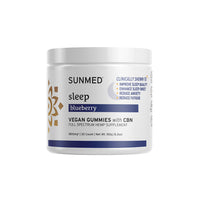Does CBD affect REM sleep?

Medically Reviewed by: Dr. Caley Scott, ND
The process of sleep seems simple enough — the body and mind relax in response to exhaustion, and deep sleep sets in. However, when we look at sleep through the lens of science, we learn a lot more about its inner workings and what really happens to the body and brain during sleep.
REM sleep is the most well-known stage of sleep, though it’s only one of many. Improving REM sleep is a good starting point in any sleep hygiene journey — so where can you start? Research has shown that cannabidiol might help, so we’ll be looking at the connection between CBD and sleep to make sense of their relationship.
Fixing sleep problems takes effort and applied strategy over time, but with CBD, you’re already on the right track. Let’s find out how CBD affects REM sleep and how to use it the right way, ensuring you get the quality sleep you need every night.
What Is REM sleep?
Rapid eye movement (REM) sleep is a stage of sleep characterized by high levels of electrical activity in the brain. By measuring electric patterns using electroencephalography (EEG), researchers have found that REM is distinct from the other stages of sleep, and is involved in unique processes of rest and rejuvenation.
Brain activity is so vibrant during REM sleep that it almost resembles that of someone who is alert and awake. This led researchers to believe that REM is the stage of sleep where most vivid dreams occur, as brain waves spike along with eye movement beneath closed eyelids.
While dreams can happen in other stages of sleep, the most immersive and active dream states are unique to REM. In fact, the body experiences muscle atonia, a form of temporary muscular paralysis, during REM to prevent itself from injury.
In terms of functions, REM sleep is believed to play a role in many cognitive processes, such as memory consolidation and emotional regulation. Waking up during a REM cycle can lead to phenomena such as sleep inertia, which can be accompanied by groggy or fuzzy mental states. Emotions experienced in dreams can also cross over from REM to waking, and it’s common to feel the same emotions from the dream as you exit this stage of sleep.
How is REM sleep different from other types of sleep?
REM sleep is unlike any other stage of sleep. From increased brain activity to vivid dreams and emotional responses, there are still many mysteries to uncover. However, the best way to understand REM in full is to compare it to the other stages of sleep we know about.
Here is an overview of the other three stages of sleep that we experience each night and how they stack up in measurements and functions compared to REM.
Stage 1 (NREM-1)
The first stage of sleep is defined by the transition between wakefulness and deep sleep, and it typically only lasts a few minutes. If your sleep latency is low — meaning you fall asleep quickly — you should be able to enter stage 1 sleep without delay. This is the foundation of good sleep, ensuring you can smoothly transition from waking to an unconscious state to navigate each stage in complete cycles.
In stage 1 sleep, your body undergoes significant changes, not only in your state of consciousness, but also in brain activity and physiological shifts as well. It starts with the total relaxation of skeletal muscle tissue, though you don’t experience the complete muscle atonia that happens during REM. While muscles relax, there may still be involuntary muscle contraction during stage one, known as hypnic jerks. Though they may be surprising and disrupt your entry into stage 1 sleep, these unexpected jolts are normal and harmless.
EEG readings show that brain waves also change patterns during the transition from wakefulness to stage 1 sleep. While beta brain waves are detected during our waking hours, these morph into slower alpha brain waves during the first stage of sleep. This suggests that the body and mind are no longer capable of processing external stimuli, and this sensory reduction characterizes the shift to deep sleep.
Although stage 1 doesn’t appear to play a part in memory consolidation and cognitive restoration like REM, it’s important nonetheless. This short stage, lasting one to five minutes, ensures the body and brain will navigate each stage in full, including REM.
Stage 2 (NREM-2)
As you complete your first cycle of stage 1 sleep, you shift to stage 2, another vital part of the entire sleep journey. A stage 2 sleep cycle typically lasts 10 to 25 minutes, which means we spend far more time in stage 2 than in stage 1.
Here, we encounter a new phenomenon known as sleep spindles. These are short bursts of brain wave activity that last just a few fractions of a second. Research shows that sleep spindles may be signs that the brain is starting to consolidate memories and even start producing dream states, though not to the same degree as REM sleep.
Moreover, stage 2 sleep is significantly deeper and more steady than stage 1. The body enters an even deeper state of physical relaxation, and despite the presence of the occasional sleep spindle, the brain shows signs of long, slow brain waves called K-complexes. Meanwhile, heart rate and body temperature begin to stabilize, and awareness reduces even further. It becomes more difficult to wake up from stage 2, though it’s not the deepest stage of sleep.
Stage 3 (NREM-3)
Once stage 2 sleep concludes, we progress to stage 3, which is known as the longest and deepest sleep stage — even more so than REM. Stage 3 sleep can last up to 40 minutes at a time, meaning we spend most of our resting hours in this stage.
Slow-wave sleep is the definitive feature here, with slow delta waves showing up on EEG readings. Muscles are completely relaxed, suggesting this is when the body performs most of its repairs on muscle tissue, organs, and other physical components.
Additionally, stage 3 sleep is where growth hormone is released, which is crucial for recovery and physical development in young people. This is also where certain sleep disorders may emerge, including sleepwalking or bedwetting.
Stage 3 sleep is important for these reasons and more, but it’s also the last stop before we reach REM sleep. Each aspect of sleep is critical to total rest and recovery, both in the physical and psychological realms.
How does CBD affect sleep?
With a better understanding of the sleep stages and how they work, we can start to see how a compound like cannabidiol (CBD) comes into play to facilitate high-quality sleep.
This exploration starts with the body’s endocannabinoid system, which contains neurotransmitters and receptors that induce the effects of CBD and other compounds of the hemp plant. CBD, for instance, targets CB1 and CB2 receptors, which are found throughout the brain, muscle, and organ tissue, and even the skin and joints.
Because the ECS is so deeply entrenched in the body’s many systems, it follows that regulation and balance of this network would help with sleep. This becomes even clearer when we look at the most common effects of CBD on the body, which include relaxation, calmness, and tension-soothing benefits.
For example, CBD may be taken to ease feelings of nervousness or discomfort, both common culprits in problems related to sleep.* For those hoping to fall asleep on time, CBD may support healthy sleep latency and ensure a proper transition to stage 1, starting the cycle as it’s meant to be.
Some studies also show that CBD helps support the sleep-wake cycle overall, which helps our body maintain its “internal clock” that is necessary for productive sleep. While supplements like melatonin may also help optimize sleep-wake cycles, CBD offers a more sustainable approach and does not deplete the body’s natural hormones required for deep sleep.
Does CBD affect REM sleep specifically?
With minimal side effects and proven benefits for better sleep, it’s clear why CBD products are increasingly popular — but when looking at REM sleep specifically, it’s not apparent that CBD impacts this specific stage.
This knowledge gap is partially due to the mysteries that still surround REM sleep itself. While we know some defining characteristics of REM sleep, there is no scientific consensus on what exactly happens during this time, or how CBD can help.
However, we can confidently say that CBD does contribute to sleep quality by supporting overall relaxation. The effects of cannabidiol on the central nervous system and ECS are well documented, and any aspect of sleep that you can improve will benefit your good night’s sleep overall.*
With that said, there is so much more to discover about sleep architecture, sleep medicine, and the various sleep stages themselves. CBD can certainly make a difference, even if we aren’t sure about its effects on REM.*
What other cannabinoids affect sleep?
CBD is the most popular non-psychoactive cannabinoid by far, and its use as a form of natural sleep support is nothing new. However, are there other cannabinoids that can benefit sleep that should be on your radar? Let’s compare the effects of CBD to other hemp compounds and the cannabis plant in general.
THC
Tetrahydrocannabinol (THC) is the most well-known psychoactive cannabinoid, producing the traditional effects of a cannabis high. With altered perception and heightened senses, the THC experience is different from CBD, though the same ECS receptors are targeted with THC use.
In terms of sleep, however, research is split on whether THC has a positive effect. THC may help some individuals fall asleep faster, but the quality of that sleep isn’t necessarily where it should be. This is likely due to the changes in brain waves that THC causes in waking states, which could cause disruptions when navigating stage 2, stage 3, and REM sleep.*
If you experience poor sleep with higher doses of THC, it’s likely a sign for you to shift to CBD use for sleep or enjoy the effects of THC before you begin your evening routine.
CBN
Cannabinol (CBN) is not a new cannabinoid, but it has been the subject of a recent study that shows its promise as a form of natural sleep support. CBN is more similar in structure to CBD, with non-psychoactive effects that help the body and mind unwind and relax more fully.
For those looking to improve sleep hygiene with hemp, CBN combined with CBD might be the best place to start. Our products containing CBD for sleep offer the perfect entry point for nighttime hemp use and can ensure you stick to your circadian rhythm with minimal disturbances.*
How can you support sleep hygiene with hemp?
When it’s time to pay back your sleep debt and commit to true sleep hygiene, you don’t want to leave anything to chance. Here are some tips to support your sleep with hemp.
Know your serving size
High-quality hemp extracts do not require large serving sizes to deliver effects for relaxation and quality sleep. The best way to learn your ideal serving size is to start with a recommended beginner serving and test the effects for yourself.
Pick your preferred format
From edibles like our clinically-proven Full Spectrum Sleep CBN Gummies to CBD oil and tinctures, we have a range of effective hemp extract formats for you to choose from. Start with a product that fits your preferences and allows you to easily measure your intake amount each time.*
In the short term, this will help you build familiarity with a particular formulation and format, making it easier to stick with a lifestyle protocol over time.
Make it part of your routine
Routine is everything with sleep and health in general, so map out a plan for sleep hygiene that features CBD or CBN. For instance, you can use a CBD tincture or gummy to signal the beginning of your evening routine, roughly an hour before bed. This should give you plenty of time to set up your sanctuary, unwind, and ease into sleep as the effects of CBD take hold.
You also may find that supplementing with CBD throughout the day can help ease the transition to your nighttime routine. Find a reliable daily hemp extract that can balance your ECS and give you the full-body benefits of hemp all day and night.
The bottom line
REM sleep gets most of the attention in the world of sleep science, as it’s the most interesting and elusive of the sleep stages — but as we’ve learned, REM is just one of many components to deep sleep, and using CBD can offer support throughout various sleep stages.
If you’re ready to take sleep seriously and use hemp to your advantage, Sunmed is here to help. Explore our best-selling Sleep products today and get back on track with the sleep you truly need.*
Sources:
Stages of Sleep: What Happens in a Sleep Cycle | Sleep Foundation
Sleep Disorders and Sleep Deprivation: An Unmet Public Health Problem | NIH
Physiology, Sleep Stages | NIH
Cannabinol: History, Syntheses, and Biological Profile of the Greatest “Minor” Cannabinoid | PMC
Cannabis, Cannabinoids, and Sleep: a Review of the Literature | NCBI











